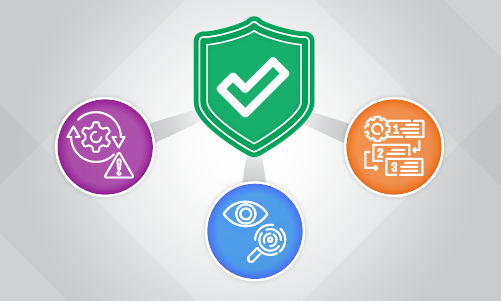Table of Contents
Vulnerability management (VM) is a systematic, continuous process of identifying, evaluating, and remediating security weaknesses across an organization’s systems and infrastructure. This comprehensive look explores how to build and maintain an effective vulnerability management program that protects your assets, and grows vulnerability management into the exposure management of emerging threats, while balancing security needs with business objectives.
The evolving security landscape
Modern vulnerability management faces mounting challenges as digital transformation expands attack surfaces and threats grow increasingly sophisticated. Organizations need structured approaches to finding and fixing security weaknesses before attackers can exploit them. The increasing complexity of IT environments, coupled with the rapid pace of software development and deployment, makes traditional approaches to security insufficient.
Today’s organizations must contend with rapidly expanding digital footprints, sophisticated threat actors, and evolving compliance requirements. The shift to cloud services and hybrid environments has introduced new complexities in identifying and managing vulnerabilities. Remote work adoption has further expanded potential attack surfaces, making comprehensive vulnerability management more crucial than ever.
Building an effective vulnerability management program
Creating a robust vulnerability management strategy starts with understanding your environment. This means maintaining accurate asset inventories of systems while implementing processes to discover and assess new resources as they’re operationalized and deployed. Organizations must develop comprehensive asset management practices that account for both traditional infrastructure and modern cloud resources.
Additionally, a scanning technology comprehensive approach combines multiple risk assessment methods to ensure thorough coverage. Network scanning ensures broad visibility to identify potential weaknesses, while penetration testing reveals subtle vulnerabilities that automated tools might miss. Web application testing identifies risks specific to externally-facing systems and services.
Regular vulnerability scanning and assessment forms the foundation of effective detection. Organizations should implement automated asset scanning tools that regularly probe networks, systems, and applications for known vulnerabilities. This should be complemented by periodic manual assessments and penetration testing to identify weaknesses that automated tooling might miss.
Clear remediation workflows and procedures ensure consistent vulnerability handling. Organizations need documented processes that define how: issues are tracked, prioritized, and addressed. These workflows should specify and assign: roles and responsibilities, approval requirements, and timelines for different types of vulnerabilities, severity, and business impact.
Continuous monitoring and validation ensure vulnerabilities continue to be in a resolved state. Beyond initial scanning and remediation, organizations need ongoing monitoring to detect actual regression or new asset issues. This includes monitoring: system configurations, reviewing asset security controls, and validating that patches are effective over time.
Robust reporting and metrics tracking to leadership provides visibility into program effectiveness. Organizations should develop and maintain meaningful metrics that: track, not just the number of vulnerabilities, but also factors like mean time to remediate, recurring issues, and risk reduction trends. Regular metric reporting establishes accountability, demonstrates program value, and identifies areas that require improvement.
Successful programs leverage these components within an integrated framework that aligns security efforts with business objectives. This comprehensive approach helps organizations maintain a strong security posture while efficiently managing resources.
Understanding risk levels
After scanning technologies identify vulnerabilities, security teams must evaluate their significance through both technical and business lenses. A technical evaluation examines factors such as: exploitation probability, patch reliability, and external network exposure. Business context adds crucial perspective by considering: data sensitivity, system criticality, and potential customer impact.
Risk assessments require understanding multiple dimensions of each vulnerability. Teams must consider not only the technical severity, but also the business context in which the vulnerable system operates. This includes evaluating potential impact on operations, customer data, and regulatory compliance. Risk should either be mitigated or accepted by management.
Environmental factors significantly influence risk levels. Externally-facing assets should be evaluated with higher scrutiny. Network segmentation could limit vulnerability exposure, while strong access controls may reduce exploitation likelihood. However, programs should consider and weigh many factors, and document business risks. Some areas to consider are: weak monitoring capabilities or inadequate incident response preparedness that can amplify potential impacts to business operations.
Vulnerability prioritization framework
Given resource constraints, organizations must carefully prioritize remediation efforts. This requires balancing technical risk factors with business constraints, while also maintaining flexibility to address emerging threats. Impact assessments examine potential consequences of exploitation, with critical systems warranting faster response and remediation.
Resource planning matches remediation needs with available capabilities. Some fixes require specialized expertise, while others require dedicated testing. Understanding these requirements helps create realistic schedules that consider both security needs and operational constraints.
Implementation strategies must consider assets critical to business impact and operational requirements. Teams require clear procedures for: testing changes, validating fixes, and documenting results. Post-remediation validation scans confirm vulnerabilities have been properly addressed without introducing new issues.
Essential remediation components include:
Implementation and validation
Successful remediation requires coordinated effort across teams. Clear processes and strong communication enable efficient execution while maintaining proper controls. Change management ensures modifications follow established procedures, with testing requirements varying by system criticality.
Change management procedures
Organizations must establish clear change control processes that define how vulnerabilities are remediated. This includes scheduling maintenance windows, obtaining necessary approvals, and following standardized deployment procedures. Each change should have a clear rollback plan in case unexpected issues arise during implementation.
Testing requirements
Before deploying fixes, organizations need comprehensive testing protocols based on system criticality. Critical systems require some level of testing in development and staging environments before production deployment. Testing should consider exposure risk, remediating identified risks, and/or management risk acceptance. Once risk is either remediated or accepted, testing ensures business operations are evaluated and risks are documented.
Documentation standards
Proper documentation ensures: accountability, consistency, and knowledge is transferred to accountable teams. Organizations should maintain detailed records of: each vulnerability, including initial discovery, risk assessment, risk acceptance, remediation steps taken, testing results, and final risk validation. This documentation proves valuable for internal and external audit purposes and helps teams handle similar issues more efficiently in the future.
Stakeholder communication
Regular communication with affected stakeholders helps minimize business disruption. Teams should provide advance notice of planned remediation activities, especially for changes that might impact operations. Status updates during implementation help stakeholders track progress, while post-remediation reports confirm successful resolution. Clear escalation paths ensure quick response if issues arise during remediation.
This systematic approach to remediation helps organizations efficiently address vulnerabilities while maintaining operational stability. Proper planning and documentation supports continuous improvement of the vulnerability management program.
Vulnerability management program measurement and improvement
Regular VM program assessment ensures program gaps are identified, while metrics track progress toward security goals. Effective measurement requires both quantitative and qualitative evaluation of program performance. This includes tracking team remediation efficiency, established and agreed-upon coverage metrics, and overall risk mitigation.
Organizations should establish clear key performance indicators that align with business objectives. These metrics help demonstrate program value while identifying areas for improvement. Regular review ensures the program continues meeting organizational needs.
The importance of vulnerability management policies
These policies establish essential frameworks for systematically identifying and fixing security weaknesses across an organization’s systems. They define key requirements like scanning schedules, remediation timelines, and team responsibilities, ensuring a consistent approach to maintaining security and compliance.
Building team capabilities
Success requires more than just tools and processes. Teams need appropriate skills and knowledge to execute effectively. Training helps accountable team members stay current as threats evolve, while clear procedures guide common scenarios. Knowledge sharing spreads expertise across the organization.
Cross-team collaboration proves essential for program success. Security teams identify issues, while operations handles implementation. Development teams address code-level vulnerabilities, and leadership provides strategic direction and resource support.
Vulnerability management technology and integration
Modern security programs leverage various technologies to improve efficiency. Assessment platforms automate discovery across environments, while workflow systems coordinate remediation. Analytics help predict emerging risks, and dashboards provide visibility into program performance.
Integration between tools reduces manual effort while maintaining consistency. Automated handoffs streamline processes, while APIs enable custom reporting and metrics collection. Careful tool selection and integration helps maximize program effectiveness.
Building organizational support for VM programs
Executive sponsorship enables program success. Clear communication helps stakeholders understand security’s business value. Regular reporting maintains visibility into program effectiveness and demonstrates return on security investments.
Leadership must understand both technical and business aspects of vulnerability management. This includes measuring program effectiveness, with established metrics. Leaders must have visibility into how the program supports organizational objectives while managing security risks. Ongoing stakeholder engagement ensures continued program support and resource allocation.
Future trends and evolution of vulnerability management
Security programs must adapt as technology and threats advance. Cloud adoption changes assessment needs, while DevOps integration enables faster response. Automation expands coverage and reduces manual effort. Organizations must stay current with emerging technologies and evolving threat landscapes.
Artificial intelligence and machine learning offer new capabilities for vulnerability detection and prioritization. Automated remediation tools help speed response times, while improved analytics enable better risk prediction. Integration with development pipelines supports faster, more secure software delivery.
Conclusion
An effectively measured vulnerability management program delivers significant value through systematic evaluation and remediation of security weaknesses. However, organizations often struggle to implement these processes across siloed and divided IT teams. Success requires balancing rigorous vulnerability scanning with risk-based prioritization that considers and leverages business impacts. By including various stakeholders throughout the strategic process, and aligning security with business objectives, organizations can better protect their assets in today’s dynamic threat landscape.




